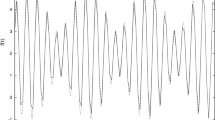Abstract
This study addresses identification of the quasi-periodic sequence based on the discrete Fourier transform spectrum-sparsity. A quasi-periodic signal displays similarities to a periodic signal but does not satisfy its strict definition. Then identification of the quasi-periodic signal is practically a requirement for many applications. The spectrum-sparse property in the Fourier domain is presented for describing the discrete-time periodic signals, and then it is extended and proposed for the quasi-periodic sequence identification. The proposed identification method is applied to real applications including periodicity detection of the sunspot activity, rainfall activity, and air temperature movement as well as the pile driver sound detection. The experimental results and analysis indicate potentiality of the proposed method that it yields satisfying results in the real applications.










Similar content being viewed by others
References
R.G. Baraniuk, Compressive sensing. IEEE Signal Proc. Mag. 24, 118–124 (2007)
C. Candan, M.A. Kutay, H.M. Ozaktas, The discrete fractional Fourier transform. IEEE Trans. Signal Process. 48, 1329–1337 (2000)
E.J. Candes, J. Romberg, T. Tao, Robust uncertainty principles: exact signal reconstruction from highly incomplete frequency information. IEEE Trans. Inf. Theory 52, 489–509 (2006)
E.J. Candes, T. Tao, Near-optimal signal recovery from random projections: universal encoding strategies? IEEE Trans. Inf. Theory 52, 5406–5423 (2006)
E.J. Candes, W. Michael, An introduction to compressive sampling. IEEE Signal Proc. Mag. 25, 21–30 (2008)
E.J. Candes, Y. Plan, A probabilistic and RIPless theory of compressed sensing. IEEE Trans. Inf. Theory 57, 7235–7254 (2011)
D. Dohoho, Compressed sensing. IEEE Trans. Inf. Theory 52, 1289–1306 (2006)
P. Duhamel, B. Piron, J.M. Etcheto, On computing the inverse DFT. IEEE Trans. Acoust. Speech Signal Process. 36, 285–286 (1988)
P. Duhamel, M. Vetterli, Fast Fourier transforms: a tutorial review and a state of the art. Signal Process. 19, 259–299 (1990)
S. Gurevich, R. Hadani, N. Sochen, The finite harmonic oscillator and its applications to sequences, communication and radar. IEEE Trans. Inf. Theory 54, 4239–4253 (2008)
S. Gurevich, R. Hadani, On the diagonalization of the discrete Fourier transform. Appl. Comput. Harmon. Anal. 27, 87–99 (2009)
National Aeronautics and Space Administration (NASA): The Sunspot Cycle. http://solarscience.msfc.nasa.gov/SunspotCycle.shtml. Accessed 1 Jan (2011)
D.J. Nyarko, K.A. Strsmsmoe, in Proceedings of the IEEE on Electrical and Computer Engineering (Calgary, Alta), pp. 708–711 (1996)
A.V. Oppenheim, R.W. Schafer, Discrete-Time Signal Processing (Prentice-Hall, Upper Saddle River, 1989)
C. Reller, H.-A. Loeliger, J.P.M. Diaz, in 19th European Signal Processing Conference (Barcelona, Spain), pp. 971–975 (2011)
J. Stalker, Complex Analysis: Fundamentals of the Classical Theory of Functions (Springer, Berlin, 1998)
D. Tominaga, K. Horimoto, Judgment alforithm for periodicity of time series data based on bayesian information criterion. J. Bioinform. Comput. Biol. 6, 747–757 (2008)
D. Tominaga, Periodicity detection method for small-sample time series datasets. Bioinform. Biol. Insights 4, 127–136 (2010)
J.A. Tropp, A.C. Gilbert, Signal recovery from random measurements via orthogonal matching pursuit. IEEE Trans. Inf. Theory 53, 4655–4666 (2007)
J.G. Vargas-Rubio, B. Santhanam, On the multiangle centered discrete fractional Fourier transform. IEEE Signal Process. Lett. 12, 273–276 (2005)
S. Vaughan, A simple test for periodic signals in red noise. Astron. Astrophys. 431, 391–403 (2005)
Z.C. Yang, A study on the orbit of air temperature movement. Environ. Model. Assess. 12, 131–143 (2007)
P. Zubrycki, A. Petrovsky, in IEEE Proceedings on Circuits and Systems (France, Paris), pp. 2374–2377 (2010)
Acknowledgments
The research was supported by Scientific Research Fund of Hunan Provincial Science and Technology Department (2013GK3090) and Research Fund of Hunan University of Science and Technology (E50811).
Author information
Authors and Affiliations
Corresponding author
Rights and permissions
About this article
Cite this article
Yang, Zc. DFT Spectrum-Sparsity-based Quasi-Periodic Signal Identification and Application. Circuits Syst Signal Process 34, 3543–3557 (2015). https://doi.org/10.1007/s00034-015-0022-8
Received:
Revised:
Accepted:
Published:
Issue Date:
DOI: https://doi.org/10.1007/s00034-015-0022-8




